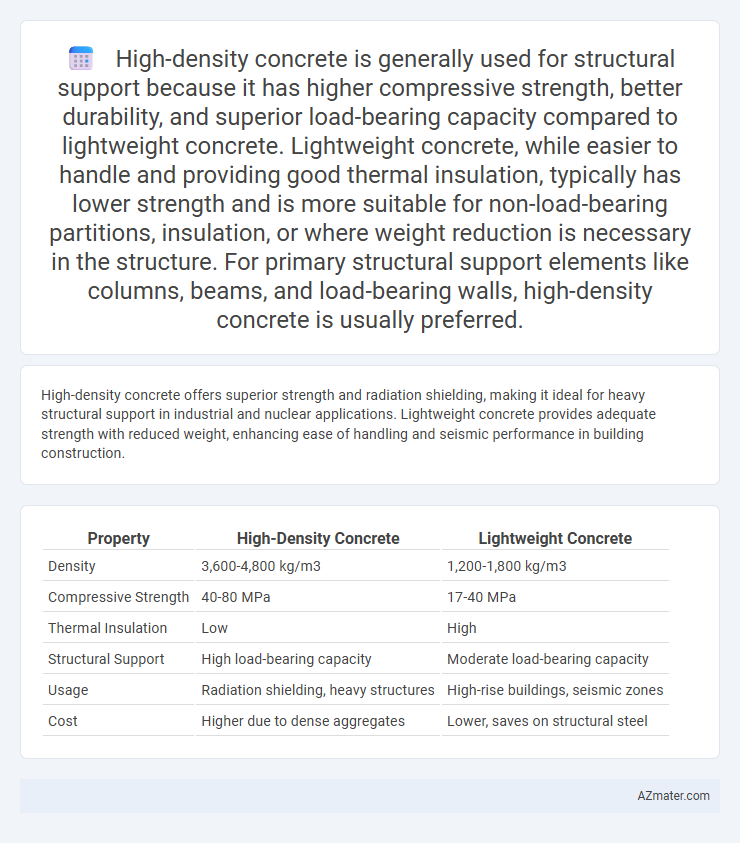High-density concrete offers superior strength and radiation shielding, making it ideal for heavy structural support in industrial and nuclear applications. Lightweight concrete provides adequate strength with reduced weight, enhancing ease of handling and seismic performance in building construction.
Table of Comparison
| Property | High-Density Concrete | Lightweight Concrete |
|---|---|---|
| Density | 3,600-4,800 kg/m3 | 1,200-1,800 kg/m3 |
| Compressive Strength | 40-80 MPa | 17-40 MPa |
| Thermal Insulation | Low | High |
| Structural Support | High load-bearing capacity | Moderate load-bearing capacity |
| Usage | Radiation shielding, heavy structures | High-rise buildings, seismic zones |
| Cost | Higher due to dense aggregates | Lower, saves on structural steel |
Introduction to Concrete Types for Structural Support
High-density concrete features a higher density due to heavy aggregates like barite or magnetite, providing superior radiation shielding and increased load-bearing capacity ideal for structural support in specialized applications. Lightweight concrete incorporates porous aggregates such as expanded clay or shale, offering reduced dead load, improved thermal insulation, and enhanced fire resistance while maintaining adequate structural strength. Selection between high-density and lightweight concrete depends on factors like structural requirements, weight constraints, and environmental conditions to optimize performance and safety.
Overview of High-Density Concrete
High-density concrete, composed of heavy aggregates such as barites or magnetite, offers superior strength and radiation shielding properties, making it ideal for structural support in specialized applications like nuclear facilities and heavy infrastructure. Its increased density, typically ranging from 3000 to 4500 kg/m3, enhances load-bearing capacity and durability compared to standard concrete. This high-density composition results in improved impact resistance and reduced permeability, ensuring long-term structural integrity under extreme conditions.
Characteristics of Lightweight Concrete
Lightweight concrete is characterized by its lower density, typically ranging from 90 to 115 pounds per cubic foot, achieved through the use of lightweight aggregates such as expanded clay, shale, or pumice. This concrete type offers reduced dead load on structures, enhanced thermal insulation, and improved fire resistance, making it ideal for non-load bearing walls, roofing, and precast units. Despite its lower strength compared to high-density concrete, lightweight concrete provides sufficient structural support in applications requiring weight reduction without compromising durability.
Strength and Load-Bearing Capabilities
High-density concrete offers superior compressive strength and enhanced load-bearing capabilities, making it ideal for heavy structural support in high-load applications such as nuclear power plants and radiation shielding. In contrast, lightweight concrete provides moderate strength with significantly reduced self-weight, improving seismic performance and ease of handling in building construction. The choice between high-density and lightweight concrete depends on the specific structural requirements, where high-density concrete maximizes strength and durability, while lightweight concrete optimizes weight reduction and energy efficiency.
Durability and Longevity Comparisons
High-density concrete offers superior durability and longevity for structural support due to its enhanced resistance to impact, abrasion, and radiation, making it ideal for heavy-duty and protective applications. Lightweight concrete, while providing excellent thermal insulation and reducing dead load, generally exhibits lower compressive strength and higher permeability, which can compromise its long-term durability under aggressive environmental conditions. The choice between high-density and lightweight concrete depends on structural requirements, with high-density concrete favored for extended service life in demanding environments.
Thermal and Acoustic Insulation Performance
High-density concrete offers superior acoustic insulation due to its mass, effectively reducing sound transmission and providing better noise control in structural applications. Lightweight concrete enhances thermal insulation by incorporating air pockets that lower thermal conductivity, making it ideal for energy-efficient buildings. Both materials balance structural support needs while optimizing specific insulation properties based on project requirements.
Applications in Structural Engineering
High-density concrete, with its enhanced density and compressive strength, is ideal for radiation shielding in nuclear facilities and heavy-duty structural components requiring high load-bearing capacity. Lightweight concrete offers superior thermal insulation and reduced dead load, making it suitable for high-rise buildings, long-span bridges, and seismic-resistant structures. Structural engineers select between these concretes based on project requirements such as strength, density, thermal properties, and cost-efficiency for optimized performance.
Construction Methods and Workability
High-density concrete offers superior load-bearing capacity and enhanced radiation shielding, commonly utilized in heavy structural supports and specialized construction projects. Lightweight concrete, featuring lower density and improved thermal insulation, simplifies handling and reduces dead load, making it ideal for long-span structures and seismic applications. Construction methods for high-density concrete often require specialized mixing equipment and extended curing times to ensure optimal strength, whereas lightweight concrete benefits from increased workability and faster setting times, facilitating quicker assembly and reduced labor costs.
Cost and Material Efficiency
High-density concrete offers superior load-bearing capacity and radiation shielding but comes at a higher cost due to its use of heavy aggregates like barite or magnetite. Lightweight concrete reduces the overall structural weight, leading to lower foundation and transportation expenses, while using materials such as expanded clay or shale improves thermal insulation and decreases dead load. For cost and material efficiency, lightweight concrete generally provides better economic value in large-scale construction projects due to reduced material consumption and faster handling.
Choosing the Right Concrete for Your Project
High-density concrete offers superior strength and radiation shielding properties, making it ideal for heavy structural support and specialized industrial applications. Lightweight concrete provides enhanced thermal insulation, reduced dead load, and ease of handling, which benefits projects requiring weight reduction without significant compromise on strength. Selecting the right concrete depends on project-specific needs such as load-bearing capacity, environmental exposure, and construction methodologies.

Infographic: High-density concrete vs Lightweight concrete for Structural support
 azmater.com
azmater.com